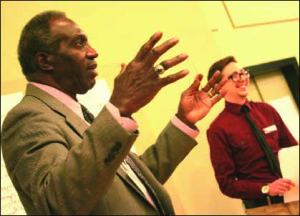Inclusion May Be As Simple As A Simple ‘Good Morning’
By JIM KEVLIN • HOMETOWN ONEONTA
Edition of Friday, Nov. 14, 2014

Inclusion can begin with a simple “good morning.”
Stated in different ways, that was one observation that came out Saturday, Nov. 8, as 60 people at “Oneonta: An Inclusive Community” engaged in “envisioneering” – Mayor Dick Miller’s term – to imagine what an optimum community might look like in 2025. The exercise, also called a Diversity Summit, was hosted at Foothills.
“I’m a hiker,” said Ellen Sokolow, Franklin, an architect. “On trails, everybody says, ‘good morning’.” She suggested the formation of a “Good Morning Committee.”
If Mayor Miller was the ultimate delegator, this was the ultimate delegation: He originated the summit idea, then passed away Saturday, Oct. 25. His delegatees, without him, struggled to move forward the idea of an Oneonta more accepting of newcomers.
The day began with a keynote by Mark Vaughn, a Ph.D. with Corning Inc. who developed “The Upward Path,” that company’s strategy to bring more diversity into its workforce.
Education in the STEM disciplines – science, technology, engineering and math – is essential to bring varied people into a workforce, because that’s where the opportunities are.
In the Southern Tier, 3.7 people are looking for every job, but there are 1.8 STEM jobs for every qualified applicant. “It is imperative to raise the bar on STEM education,” Vaughn said.
(He also encouraged the pursuit of STEAM, the added “A” standing for arts, “which brings people together,” he said.)
After his address, the gathering broke into 11 groups to discuss a common question on achieving diversity, and a more specific one, and ideas were wide-ranging.
“From an economic-development standpoint, we need a Target,” said Kathy Wolverton, City Hall’s human resources director, meaning the store. Some husbands have trouble convincing wives to move here, she said, because of insufficient shopping choices.
“Getting people engaged in the county makes it more likely they will stay,” said attorney Andrew Stammel, an Oneonta Town Board member.
Kellie Place, the Realtor who chairs the community arts council that grew out of Miller’s first summit, in 2010, urged “more community-sponsored gatherings to encourage people to get together.”
People – even college students – can surprise you, said Michael Stoltzer, who runs a downtown art gallery and owns student housing. Despite student rowdiness and public drunkeness much decried this fall, Stoltzer, interacting with his tenants, is “amazed by how respectful, intelligent and interesting they can be.”
At morning’s end, the groups reconvened and reported back their conclusions, which were written down on flip charts. Each participant was they provided with five color stickers to vote on what they found to be the most promising suggestions.
Among the largest vote-getters were: a welcome-center committee, observing multi-cultural holidays, person-to-person outreach, creation of a community college to put people on the road to success.
“At least in Oneonta, it’s a can-do situation,” said Lee Fisher, president of the Oneonta NAACP.
“We have to reconcile ourselves to the discomfort that comes with this work,” said Elliott Ruggles, director of SUNY Oneonta’s Center for Gender & Sexual Equality.
Susan Turell, dean of SUNY’s School of Social Science, chaired the steering committee that put the summit together.
In an interview, she said Mayor Miller saw the movie, “Brothers of the Blacklist,” which raised questions in his mind.
“How do we deal with the problems around diversity,” he asked when he convened the steering committee last winter.
“If we’ve been dealing with it for 20 years” – SUNY Oneonta’s blacklist incident was in 1002 – “we have not been dealing with it well.”
Turell said there will be at least one more meeting of the steering committee, where the summit findings will be reviewed and a determination made on the next steps.

